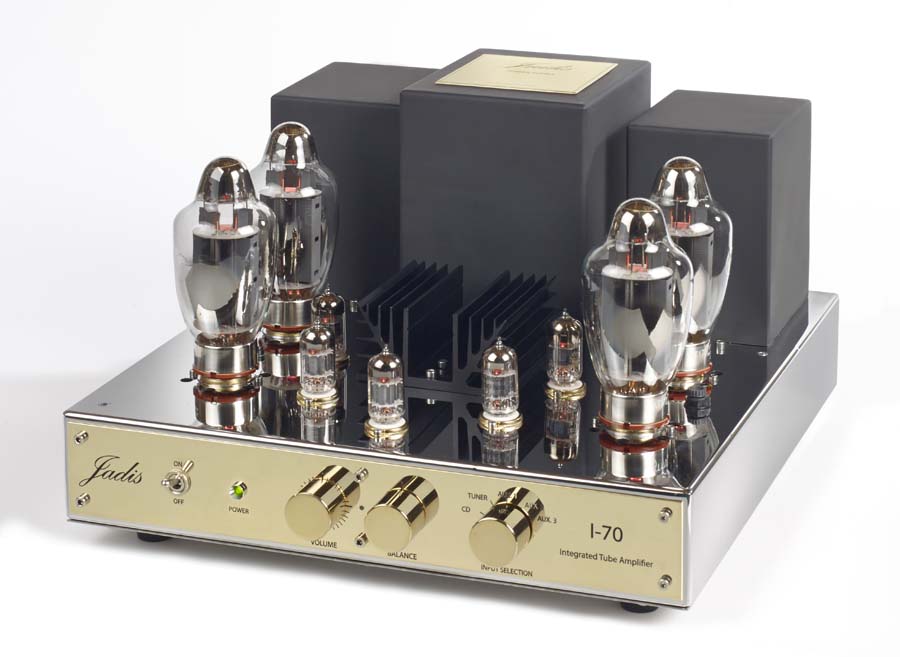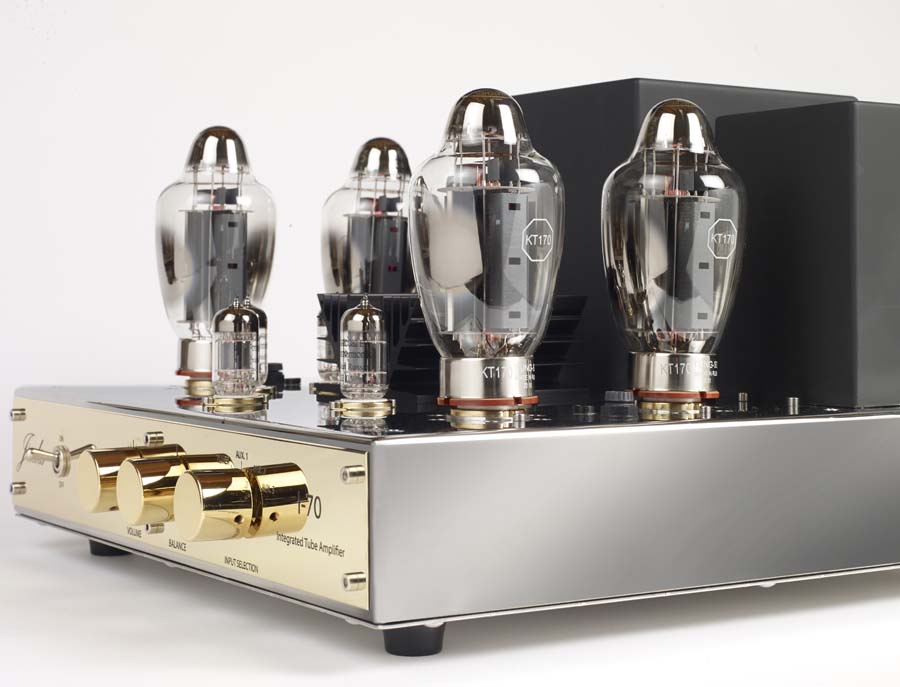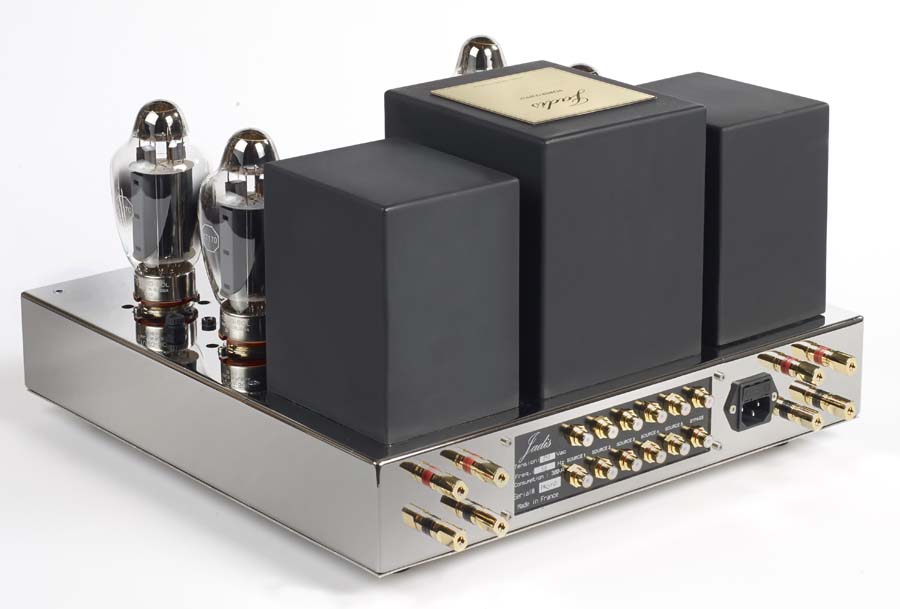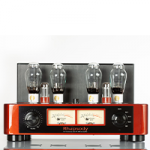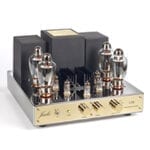JADIS I70 INTEGRATED VALVE AMPLIFIER REVIEW
Jadis’ I70 Integrated Amplifier uses the KT170 valve/tube in a 50w per channel powerhouse of an amplifier that, with its stainless steel and gold finish, could only be from this French manufacturer. Stuart Smith takes a listen and is somewhat blown away.
I’ve been looking forward to this amplifier arriving since we chatted with the guys from Jadis at the Paris show way back in October of 2021. For those of you that don’t know, Jadis is a French valve amplifier manufacturer based in Villedubert, South East of Toulouse in France. The company launched in 1983 following the success of prototypes built by André Calmettes and a desire to build amplifiers based on his philosophy for a wider audience.
The big talking point with regards to Jadis is their output transformers, which they build themselves – they are hand-wound and then poured into a resin to maximise thermal stability and eliminate the dreaded transformer hum. The transformers make up a good deal of the 40Kg of this, the latest integrated amplifier from Jadis.
It’s an absolute beast of an amplifier that arrived in its own wooden crate!
I’d wrongly assumed that Jadis only made amplifiers, but they also make CD players, DACs, and record players. However, it is amps that Jadis are most famous for and their current lineup boasts 9 preamplifiers, 8 power amplifiers, and 9 integrated amplifiers. This seems a lot of products for one manufacturer.
As I mentioned, the fully Class-A I70 is a weighty animal, but it’s also a bit of a looker with its stainless steel chassis and 24ct gold plated brass fixtures. I’m not one for an overly bling HiFi, but the I70 manages to pull this off and I actually like the way it looks a great deal. That said, I think the remote control could be more in keeping with the design of the amplifier.
Before I get into the features of the amplifier itself, I had a chat with Jean-Christophe Calmettes about this specific amplifier that uses the new KT170 tube.
HP: The KT170 is a relatively new tube, what do you think its characteristics are and why have you chosen it in this amplifier?
The most interesting, of this tube’s characteristics, is its plate power dissipation. The Tungsol brand is well known to do good tubes and so we were sure to obtain good sound if we chose the right technical solution to allow these tubes to sing. We didn’t choose this tube for this amplifier, we designed this amplifier around this tube.
HP: The KT170 is a very powerful output tube but the I70 runs at a very modest 50W, what is your reasoning for this?
First, power is not an issue for us, our design allows for huge peak power. 50W for a single push/pull pure class A design is a lot – with an EL34 PP you obtain only 25W. Our reasoning is that we prefer to reduce distortion than simply make the amplifier more powerful, which is not necessary.
HP: What features does the I70 borrow from Jadis monoblocs?
Mainly on the power supply architecture. The driver stage and power stage are fed by independent PSUs and this means two different windings on the transformer, two different rectifying and filtering, plus, this last function is also separated on each channel. This reduces the influence of one PSU on the other. The tubes loading is triple as for monobloc.
The driver stage power supply has to be very stable in order for the stage to be stable. This stage is the gain stage, it amplifies the signal a lot and the signal is made by the PSU voltage. It should be very clean too. The Power voltage doesn’t need to be so stable because the power tubes are not so sensitive, but the load of the PSU can change and cause instability. A separate power supply allows for accurately adjusting the voltage value to the used tubes and avoiding instability.
FEATURES AND BUILD
I’ve touched a little on the build of this amplifier but would like to emphasise that it is impeccably well put together, weighs a ton and looks great, though this latter point is likely to divide opinion.
The front of the amp from left to right has the on/off toggle switch, a green LED to let you know the amp is switched on, the volume knob, a balance control knob, and the source selector. Nothing out of the ordinary here, but I am glad to see a balance control included and I believe it should be included on all integrated amplifiers and preamplifiers. A balance control helps fine tune the listening experience if your room is less than ideal and it allows for any discrepancies individuals may have from ear to ear.
The cage hides the four KT170s, two ECC83s, and three ECC82s. The amplifier is self-biasing which means that there’s no need for users to fanny about with setting the biasing themselves. I like this latter point as lots of folks just don’t want to get into the whole messing about with voltage meters, probes and whatnots. The cage, I would say, is pretty vital for this amplifier as the KT170s do get hot – very hot – and you’d not want to be inadvertently touching the valves. The amp does kick out a lot of heat and this may or may not be a concern for you. In these days of rising domestic energy prices, an amplifier that is dissipating excess heat may be seen as somewhat frivolous and wasteful. However, I am not here to pontificate on the rights and wrongs with regards to power consumption and my job here is to talk about this as a machine for listening to music. But, folk buying this amplifier should be aware that it gets hot and it is likely to have some impact on your electric bill, though I didn’t go check how fast the meter was spinning and the quoted power consumption is 500VA.
Around the back of the amplifier, you have five line inputs that are all on RCAs and here I would have liked to have provision for at least one balanced input – it just makes my life somewhat easier given the test gear I have. There’s a bypass output and speaker outputs that allow for bi-wiring or bi-amping. The configuration of the speaker outputs is factory set according to your loudspeakers’ impedance. The power inlet completes the whole caboodle and that’s it.
All in all the I70 is very well put together, has plenty of inputs and good quality fixings, though no provision for XLR input.
Inside the amp it’s all point-to-point wiring.
JADIS I70 INTEGRATED AMPLIFIER SOUND QUALITY
For the whole of this review I used the Jadis with our Audiovector R6 Arrete loudspeakers and fed it with a signal from our LAB12 DAC. The cables used were Tellurium Q speaker cables and Cardas interconnects. I used the Stack Audio streamer with a Way Cable USB lead to the DAC.
I’m going to start this section of the review off with the simple statement that sonically this is the best integrated amplifier we have had in the house… ever. I don’t know if that is because it is a brilliant match for the Audiovectors and there is some synergistic thing going on, but from the moment I first powered it up, it was clear that this amplifier represented something very special indeed. Yes, there is a power to the I70 that immediately takes control of the speakers, but there is also a massive amount of detail and layering of sounds within the music. I’ll waffle on about all this a bit more as we go on, but it really was only a matter of a few moments before I realised I was listening to an amplifier that ticked my boxes, floated required boats, and pressed suitable buttons. However, this could all be that emperor’s new clothes thing that folk bang on about, but I’d like to think that we get enough kit through these doors for me to be able to put that initial wow-factor to one side and listen to a product without being shocked by the new. I had assumed this amp would be uber-expensive and had a stab at around 20K, which I know sounds like stupid money for an amplifier, but we live in times where six-figure sums are not as uncommon as you would think. In reality, the I70 is a few quid short of €12,300 (£10,300 -suggested retail price is 12300€ whatever the market), which is still a chunk of dosh, but a good deal less than I guessed at given the fit, finish, and sound I was experiencing.
Anyway, on with the music!
The opening few bars of Peace Go With You Brother (As-Salaam-Alaikum) from Gil Scott-Heron and Brian Jackson’s Winter in America has an echo on the electric piano and with the Jadis in place, this just seems to go on for ages in the righthand speaker before it stops abruptly. I’m listening at low volume and obviously, I’ve heard this before and I know its there, it’s just that with the I70 there’s a greater sense of it “being there” and I did lock into it as being different to what I’m used to hearing with either our Krell or LAB12 amps. This is not a big deal in the grand scheme of things, of course, but it is moments like this that separate the very good amplifier, or any product for that matter, from the excellent. We are searchers for perfection and it’s elements such as this miniscule part of a record sounding different that make us sit up and take notice of a particular product. Likewise, on the next track, Rivers Of My Father, I feel there’s a teensy bit more sense of the piano being lifelike with regards to its decay and this has the effect that there’s more of an impression of the way the piano is being played. When we listen to music in the main we (hopefully) don’t sit and analyse a record for these details, and (hopefully) we are blissfully unaware of them being there in normal listening sessions, but them being there, whether we are aware of their presence or not, massively increases our unconscious enjoyment of a recording – well that’s how I see it, anyway, and this is why I think high-performing kit is vital in the overall enjoyment of music. The reason I think I’m hearing these small details with this amp is that it is absolutely silent in use. Nothing playing and there is silence – no valve noise, no nothing, though I don’t know how this would be on ultra-sensitive speakers.
It’s the same story on Herbie Hancock’s Cantaloupe Island. Freddy Hubbard’s cornet just soars, and again there’s a feeling of it being there over to the right of the room. There’s rasp, attack and decay, and a sense of him blowing his instrument in front of you – well, over to the right, as I said. The piano timing feels dragged on the sixth (?) note more than I’ve heard before and, again, there’s a touch more realism brought to the listening experience and with more of a swing to it. It’s an odd one to describe; I’m usually more drawn to the bass and percussion on tunes when I’m listening to music, but the Jadis draws me to other elements in the music. With that said, I’m also loving the Tony Williams plays the cymbals throughout this track. One of the things that I enjoy with great HiFi is the way that a track can be heard by way of the parts that make it up, but that doesn’t get in the way of the individual parts making a cohesive whole – perhaps that sounds a bit Pseuds’ Corner, but If you sit in front of a great system and listen you will know exactly what I’m waffling on about.
Moving onto Hardfloor’s Acperience 1 the bass kick at the start has a weird effect on it that makes it wobble a bit and I’ve never really been consciously aware of it before. Instruments come into the mix one by one and you hear every one arrive and exactly where they are in the mix. The hi-hats sound like I’ve never heard them before and are projected right out in the room bang centre, and the whole thing just feels so dynamic and fresh. I have played this tune hundreds of times at home and in clubs and I thought I knew it back to front and inside out – the Jadis brought a new perspective on this recording…and there’s the goosebumps !!! The 303 is right sounding, but there’s something else there that I think is a delay of the 303 right back in the mix that’s just a hairs-breadth more apparent today. I’ve listened to this track in some right states, but totally unenhanced this is an almost hallucinogenic experience with me being able to pick sounds out of the air.
If you thought valve amplifiers were all about a softer, less speedy and more laidback presentation then this amplifier will certainly have you re-evaluating that misconception. This is as dynamic an amplifier as I have had the pleasure of using and I’m not sure that anything that I’ve reviewed betters it in this respect. With the Jazz music and Techno I’ve mentioned so far, there’s a feeling that the I70 is able to respond to dynamic changes in the music immediately and this adds to the excitement and on-the-edge-of-your-seat expectation of what is coming next. In short, so far, I’d be lying if I described the experience of this amplifier (with these speakers) as anything but breathtaking. It may seem sacrilegious to have a high-end amp and speakers playing the kind of acid-house/techno that I have been playing but I found myself reverting to listening to this kind of music a great deal with my time with this amp and I think this is because of the dynamism and small elements in the mix it brings to the fore.
So as not to upset the folk that think I only listen to Techno with a bit of Jazz and Rock thrown in for good measure, I reached (virtually) for the excellent From Spain To Eternity: The Sacred Polyphony of El Greco’s Toledo by the Ensemble Plus Ultra. There are only eight vocalists and no music on this record with (I think) all the tracks being recorded at Ascot Priory Church. It’s easy to see the ensemble standing before me in the room and there’s a good feeling of the recording space/acoustic, though I’ve never actually been to this church…obviously. There’s a naturalness to the vocal presentation and whilst the singers come together as a whole, once again it’s easy to hear the individuals in the recording space left-to-right and front-to-back. Never is there a harshness to the upper registers and neither is there a feeling that things are rolled off at all. Again, I think that -wait for it, wait for it – inky-black silence adds to the sense of “being there” and allows the spatial aspects of the recording to shine through. Natural decays and reverbs are clear to hear.
It should not come as surprise given that this amplifier has a quoted 50W of Class-A power on tap that it goes loud, but it goes loud without losing any of the aforementioned attributes. Playing the Wet Leg album that everyone and their (worried) Mother seems to have bought, and at volumes that could be accused as being neighbour-bating if we had such things, was a real treat. Even at this kind of volume, it was clear that the detail and small nuances to the music were still apparent and with there being a real sense of the production on this record – It’s a lot like HoneyBlood’s debut record in this (and other) respects, though the latter is unplayable on all but the most basic of systems.
Sonically, I really am struggling to find any fault in this amplifier. At all! Full stop!
QUIBBLES
Remote is a bit meh and I really would want a better one than the one that came with the I70. It works and whatnot, but it’s a bit crap given the fit and finish on the amplifier. I mention this in most reviews and Jadis aren’t on their own, but come on, a €12,300 amp with a tenners worth of remote? Charge €12,500 and give us a remote that goes with the amplifier and reflects the Jadis brand that is in itself so identifiable!
There’s no XLR input which would have made my life a bit easier with regards to where the amp could be situated.
The amplifier does get very hot and I’m sure it devours electricity in the same way Satan devours souls, though I believe Hell is a tad cooler than this amp gets.
CONCLUSION
I make absolutely no apologies for my gushing review of this amplifier, it is absolutely wonderful and ticks all the right emotional connection boxes for me. Had it been a power amplifier rather than an integrated I’d have been having a conversation with Jadis about buying the review sample. As it is, I need to have a separate power and preamplifier for review purposes. The JA80 that can use the KT150 tube (amongst others) does look tempting, but this is a case of “once bitten, forever smitten” for me and when a standalone stereo version of this comes out I may well be having that conversation and blow the leccy bill.
What this amplifier does exceptionally well is managing to balance a tremendously dynamic performance with a hugely detailed and nuanced presentation. The amplifier reacts immediately to the need for power and this brings a fantastically exciting listening experience with all kinds of music.
Whether you are listening to Dub Reggae, Techno, Acid, Rock, Jazz or choral music the I70 doesn’t miss a trick.
AT A GLANCE
Build Quality and Features:
Beautifully put together and finished
Looks are a bit blingy
Remote is pants in comparison to the rest of the amp
The balance control, whilst many may think it as old fashioned, is a stroke of genius
Sound Quality:
Read the review – sonically, I cannot fault this amplifier at all
Dynamic and nuanced with the music coming from a dead quiet background
Value For Money:
It’s a chunk of money but you don’t need to buy a preamplifier is how I’d justify the cost when the internal negotiations start
Performance-wise this amplifier is good value for the asking price, and whilst this sounds outrageous for an amp that costs as much as a nice second-hand car, I stand by it!
We Loved:
Just listen to it with the Audiovector R6 and you will understand why I loved this amplifier so much, but that’s not really what this section is about, Stuart!
Dynamic, detailed and agile performance whatever the volume you listen at – I loved it cranked up a bit!
It has a balance control – take note, competitors
We Didn’t Love So Much:
The remote
It’s not arrived yet but the leccy bill is a worry
No XLR input
It has to go back to Jadis
Price: €12,300
Elevator Pitch Review: Made in France, the Jadis I70 could only be from this brand given its finish. Using the KT170 tubes it gets hot and no doubt uses a lot of electricity, but once it starts to play music all is well with the world! The dynamic and yet highly detailed characteristics of the amp bring a rare sense of being at one with the music and with a connection that is spellbinding! The remote is crap in comparison to the amp itself and there are only RCA inputs. However, this amplifier represents, to my mind, everything that I want from a piece of HiFi – an emotional bond to the music in a way that moves me.

Stuart Smith
Review Equipment: Stack Audio Streamer, Roon running on a NUC with Russ Andrews switch. Qobuz. Lab 12 DAC. Way Cables USB, Cardas interconnect, Tellurium Q Ultra-Diamond speaker cables. Audiovector R6 arrête speakers.

Specifications:
| Type | INTEGRATED AMPLIFIER WITH REMOTE CONTROL |
| Bias | Automatic |
| Power | 50 W |
| Input type | 5 lines, 1 Bypass output, 2 speaker output ( for bi-wiring) |
| Bandwidth | 10Hz à 36KHz |
| Sensibility | 150 mV |
| Number of blocks | 1 |
| Tubes list | 4xKT170, 2xECC83, 3xECC82 |
| Dimensions | 40 x 40 x 25.5 cm |
| Weight | 40 KG |
| Consumption | 500 VA |
















































